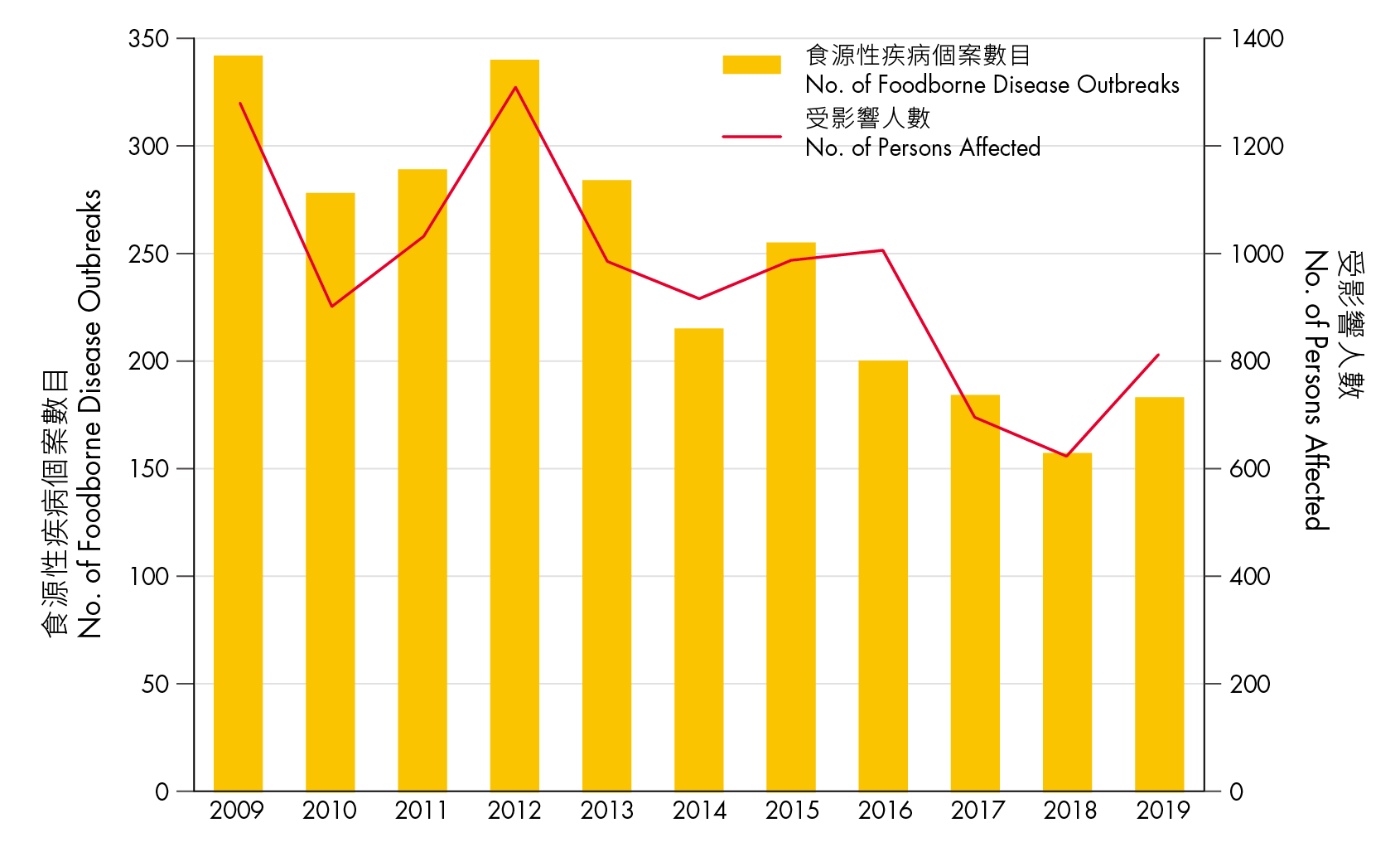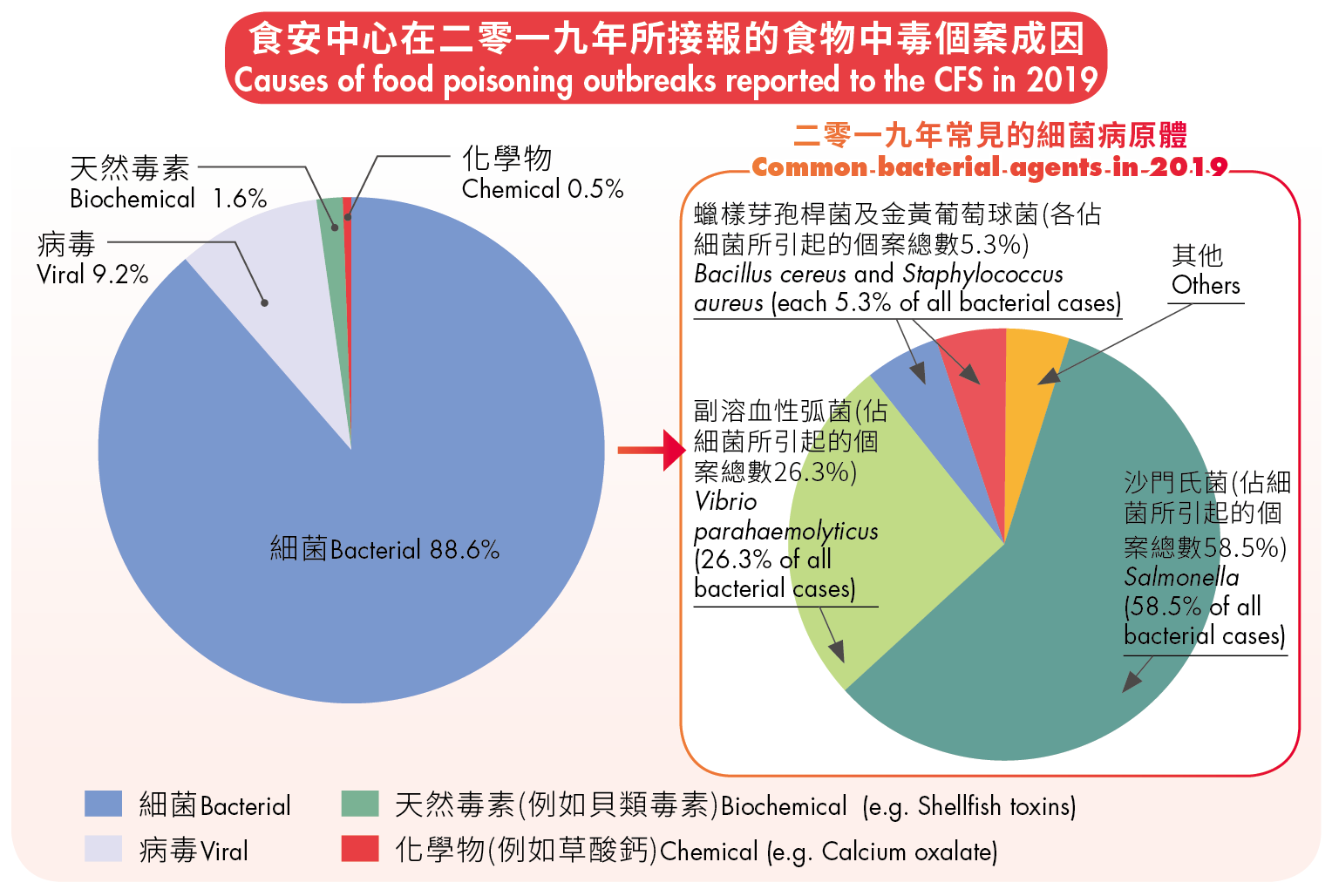
Food Safety Focus (164th Issue, March 2020) – Incident in Focus
Review of Food Poisoning Outbreaks Related to Food Premises and Food Business in 2019
Reported by Dr. Lousia CHOI, Medical & Health Officer,
Risk Management Section, Centre for Food Safety

Figure 1. Number of food poisoning outbreaks related to food premises and food business and the corresponding number of persons affected from 2009 to 2019.
Food poisoning is a statutory notifiable disease in Hong Kong. The Centre for Food Safety (CFS) of the Food and Environmental Hygiene Department, in collaboration with the Department of Health (DH), is responsible for the investigation and control of food poisoning outbreaks related to local food premises and food business. In this article, we will review the food poisoning outbreaks reported to the CFS in 2019.
Food Poisoning Outbreaks Related to Local Food Premises and Food Business
In 2019, the CFS received 184 food poisoning outbreaks referred from the DH, affecting 805 persons in total. The number of food poisoning outbreaks showed a generally decreasing trend over the past decade, although a slight increase was observed in 2019 (see Figure 1). The increase last year was mainly due to a lapse in hygiene practices in a few incidents leading to a larger scale involvement in terms of the number of outbreaks and persons affected as per illustrated in the case highlighted below.
Causative Agents and Contributing Factors
Bacterial foodborne agents remained the leading causes (88.6%) of all foodborne disease outbreaks in 2019, with the top three commonest bacterial agents similar to those in 2018. For bacterial causes in 2019, Salmonella (58.5% of all bacterial cases) topped the list, followed by Vibrio parahaemolyticus (26.3% of all bacterial cases); Bacillus cereus and Staphylococcus aureus ranked third places (both 5.3% of all bacterial cases). Viral causes accounted for around 9.2% of all the food poisoning outbreaks and Norovirus was involved in the majority of viral cases (see Figure 2). Inadequate cooking, contamination by raw food and improper holding temperature were the three most frequently identified contributing factors.
 Figure 2. Causes of food poisoning outbreaks reported to the CFS in 2019.
Figure 2. Causes of food poisoning outbreaks reported to the CFS in 2019.
Highlight on a Major Epi-linked Food Poisoning Outbreak in 2019
Clusters of Food Poisoning Outbreaks Related to Salmonella Species
In June 2019, the DH reported to the CFS 17 clusters of food poisoning outbreaks related to one restaurant, affecting a total of 40 persons. Salmonella enteritidis was isolated from the stool and blood specimens of some victims in different clusters. Epidemiological investigation of these clusters by the DH suggested that they were related to the consumption of undercooked scrambled eggs.
Field investigation in the restaurants revealed a large amount of whisked eggs, made up of 360 eggs, were prepared from unpasteurised eggs one day beforehand and stored in refrigerator at 9°C. The eggs were inadequately heated to a semi-cooked condition on the next day and kept in lukewarm water bath at 30°C throughout business hours. When orders were made, no further reheating or cooking of the eggs was done before serving to customers. In this case, the preparation of a large amount of whisked eggs too far in advance and its storage at an inappropriate temperature enhanced the growth of bacteria. Inadequate cooking of the eggs could not kill Salmonella completely and allow them to multiply again. The use of lukewarm water bath to keep the undercooked eggs for one whole day further acted as an incubator for bacteria multiplication and contributed to this large scale outbreak. Health advice was delivered to the food handlers, and the food premises was advised to suspend sale of the food items immediately and carry out thorough cleansing and disinfection. Upon the rectification of the irregularities, no further outbreaks had been reported afterwards.
Eggs have an inherent risk of contamination by Salmonella. Salmonella was found in eggs via contamination through eggshell penetration from contaminated faeces during or after laying eggs. Salmonella can also contaminate the egg before the shell is formed. It is also impossible to identify a contaminated egg from its appearance. To prevent Salmonella infection, the trade was advised to thoroughly cook egg dishes and prepare scrambled eggs on a per-order basis, avoid keeping food for a prolonged period of time, use pooled eggs as soon as possible and avoid topping up. For preparation of egg dishes without heat treatment, the trade was advised to use pasteurised eggs. Information on the presence of raw or undercooked eggs in food should be provided to customers, such as pregnant women, young children, the elderly and people with weakened immunity, for making an informed decision.
Conclusion
The number of food poisoning outbreaks has remained below 200 over the past three years. Improper food handling is the leading contributory factor for food poisoning outbreaks. While the government will continue to be vigilant in safeguarding food safety, the trade and the public are advised to follow the “Five Keys to Food Safety” to address the common contributory factors and avoid future occurrence of food poisoning outbreaks.

